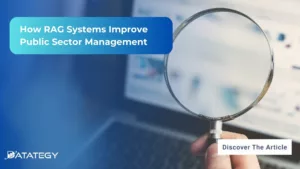How Law Firms Use RAG to Boost Legal Research RAG...
Read MorePredictive Analytics in Retail: A Game-Changer for Your Business
Table of Contents
ToggleIn the retail sector, the need to predict and anticipate is crucial as technologies develop. Today, the huge amount of data enables companies to exploit it to improve operations, reduce costs, and improve personalization. According to the latest research, 80% of retailers believe that predictive analytics is essential to their future success. (McKinsey & Company)
Find out how papAI can improve the deployment of AI projects in the Retail sector here.
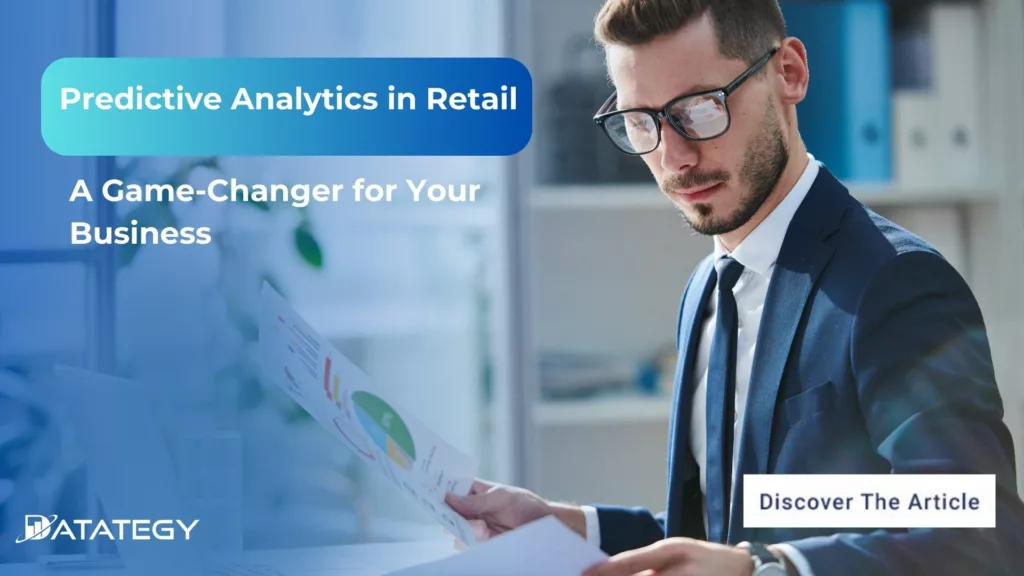
In this article, we will define predictive analytics and look at the real applications for retail businesses.
Predictive Analytics in retail: What is it?
Retail predictive analytics is the art of using past data to reveal insights that answer important and nuanced questions crucial to the success of retail businesses. In its practical application, it involves predicting specific numerical outcomes or discerning the variables that influence those outcomes and considering the consequences when those factors change.
Predictive analytics models are frequently constructed using data mining techniques, statistical methodologies, and machine learning algorithms. Following training and validation, the model may be used to forecast trends, consumer behavior, and possible obstacles, assisting organizations in anticipating future events. Predictive analytics helps businesses make data-driven choices, optimize tactics, and ultimately remain ahead of the curve in a constantly changing environment through constant improvement and adaptability.
Benefits of Retail Predictive Analytics
Retail predictive analytics has several advantages for a company. Here are five typical advantages that many, if not all, medium- and large-sized merchants find helpful when using analytics practices.
Improved loyalty and consumer experience: With the help of modern technology, businesses have a plethora of options for measuring and enhancing the customer experience. These options range from A/B testing of various versions of an experience—which is easiest to test online—to simulation-based modeling of customer flows through a store’s space. Every business will be optimizing various KPIs; for instance, a coffee shop catering to the morning rush understands its clients want to get in and out quickly, while other bars may consider it a success when patrons choose to stay longer. Providing excellent customer service always results in more customer loyalty, repeat business, positive reviews, and enthusiastic recommendations.
Five Ways to Use Predictive Analytics in Real Retail Applications
We present five comprehensive uses of predictive analytics in the retail sector:
1- Optimizing Inventory Management
Retailers compile and examine past inventory records and sales data. Predictive models based on this previous data enable companies to make precise projections about future demand. Retailers may make well-informed judgments about stock levels and avoid shortages or overstocking by analyzing seasonal fluctuations and purchase habits. This data-driven strategy is especially helpful when there are unforeseen market movements or seasonal variations.
Inventory optimization’s primary advantage is its capacity to reduce carrying costs while guaranteeing that goods are accessible when needed. Retailers can make more accurate selections about inventory thanks to predictive analytics, which boosts sales and customer happiness. This strategy offers a major competitive edge in the ever-changing retail market by streamlining operational efficiency and enhancing financial performance.
2- Dynamic Pricing Strategies
An extensive examination of previous price data, current market circumstances, and rival pricing tactics forms the basis of the approach. Retailers gather information that clarifies seasonality, pricing elasticity, and the effects of sales and promotions. Equipped with this historical data, real-time market insights like demand variations, rival price adjustments, and economic situations are incorporated into predictive pricing models. Retailers may guarantee competitive pricing, higher profit margins, and better sales performance by using predictive analytics to make well-informed pricing decisions in real-time.
Dynamic pricing techniques’ main benefit is their quick adaptation to changing market conditions. Retailers can change the pricing of certain goods or whole categories to meet customer demand, increase profitability, and stay competitive. Retailers are able to react to changes in the market instantly since this data-driven strategy guarantees that price decisions are based on actual market dynamics.
3- Enhance Fraud Detection
Data gathering, which includes financial transactions, refunds, and any questionable activity, is the first step in preventing fraud. Predictive models built on top of this data are intended to find trends and anomalies connected to fraudulent behavior. Sophisticated algorithms are used in predictive analytics to find minute abnormalities that conventional approaches can miss. Retailers can promptly avert financial losses and protect their brands by regularly monitoring these tendencies in real-time.
Predictive analytics’s capacity to provide real-time monitoring and detection is one of its most important benefits for preventing fraud. Retailers may take proactive measures to safeguard their company by putting in place systems that can quickly identify and address any suspicious activity.
4- Improve Marketing Targeting
Retail predictive analytics may assist in testing and identifying which marketing messages are most effective for different audiences, just like it can assist shops in choosing which specials to provide to different audiences. While reminding consumers about things they frequently purchase may seem like low-hanging fruit when utilizing analytics for targeted marketing, understanding customers’ priorities may be quite beneficial. Customers who consistently purchase eco-friendly goods, for instance, are more likely to react favorably to a sustainability message than those whose shopping habits suggest they’re constantly looking for the best deal.
5- Supply Chain Optimization
Comprehensive data gathering on supplier performance, lead times for transportation, inventory levels, and demand changes is the first step toward supply chain optimization. The models used in predictive analytics are built on this data.
Predictive analytics-enabled supply chain optimization results in increased productivity, lower costs, and quicker product availability. Retailers benefit from lower shipping costs, fewer stockouts, and more efficient logistics, all of which raise profitability and consumer happiness. Additionally, merchants can fulfill customer requests and keep a competitive edge in the fast-paced retail industry by being able to quickly adjust to changing market dynamics and unanticipated disruptions. Predictive analytics-based supply chain optimization is the key to retail operations success in a world where cost- and responsiveness-effectiveness are critical.
AI for Retail: A Comprehensive Guide to Choosing the Best Solution for Your Business Needs
When choosing an AI solution, consider factors such as integration with existing systems, data privacy and security, compatibility with your business needs, and scalability. By carefully evaluating these factors, you can choose an AI solution that will help your retail business thrive in an ever-changing market.

Case Study: Predict Car Sales using TSForecasting models on papAI Solution
Context
We will examine how papAI solution can be utilized in this use case to forecast the number of automobiles that each car dealer will require, and consequently, the number of cars that will be sold.
1- Data Presentation
We are going to utilize an open-data database. This database comprises the number of individual automobile orders, and it encompasses 79 weeks of daily data.
As we can see in the first few rows of the dataset above, the dataset has 8 columns which are as follows:
- Date : Datetime (DD/MM/YYYY)
- Sessions : Number of website visits on a specific day
- Online_leads_actuals : Number of visits to online shop (order online)
- Test_drive_request : Number of test drives requested
- Offer_request : Number of offers requested
- Total_configs_finished : Number of car configurations completed
- Keep_me_updated : Number of users asked to be kept updated
- Dealer_locator : Number of users who looked for a dealer location
- Private_orders : Number of times a private order has been made. This represents the total number of offline sales received. We should try to predict this field.
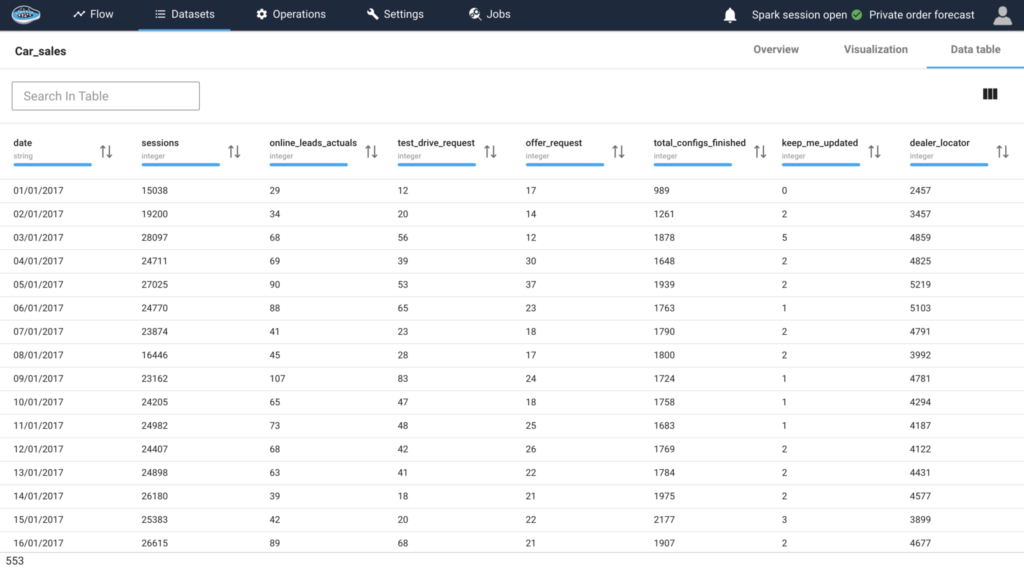
2- Data Preparation
Without requiring the manipulation of code, papAI solution enables the execution of general processing activities, hence facilitating the processing and preparation of data. A distinct module is created specifically for processing time series data, should you choose to work with such information.
The date column in the database (prior image) is of type “string,” as you can see. Since this column contains dates, the first action to do in papAI is to change the type of this column to the proper format of “date” by using the general processing cleaning.
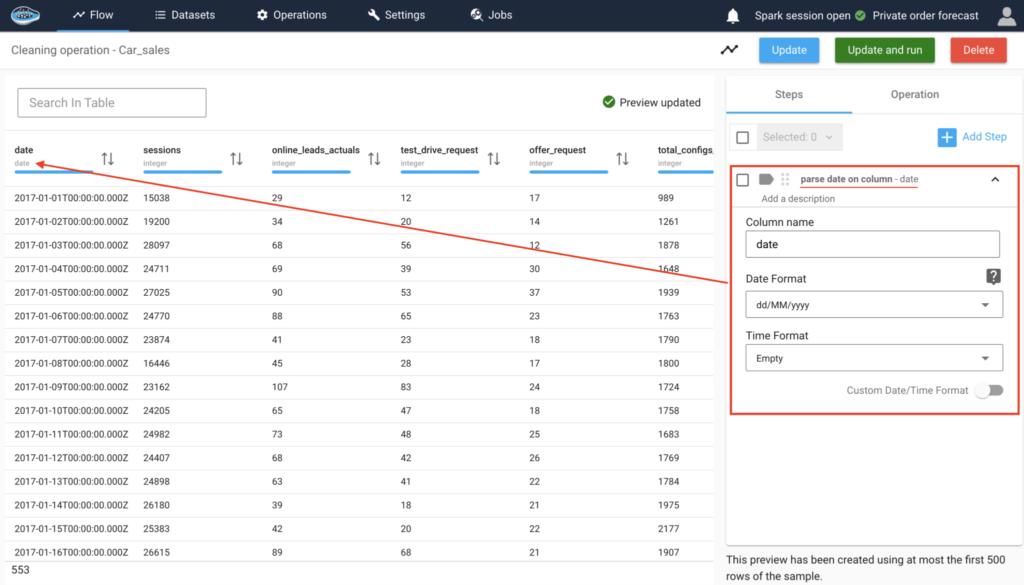
The datetime feature creation included in the TS Cleaning module of papAI Solution will be the second procedure we use. Additional information from the date, such as the day of the week, month, weekday, and year, is extracted by this procedure. This will enable us to have additional features and improve the accuracy of our predicting.
3- Machine Learning
Model Training
With papAI platform, many machine learning models may be executed concurrently without the need for coding. The user can alter these settings if desired. These models are first shown using Scikit-Learn’s default settings. papAI Solution gives us the option to select between Single series (Univariate) and Multiple series (Multivariate) while building a machine learning use case.
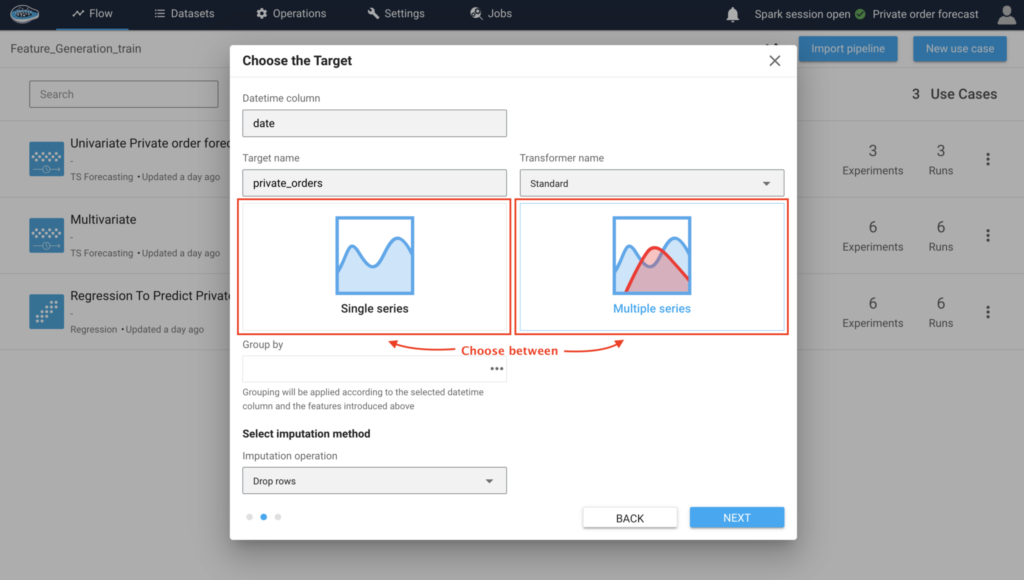
3.a) Univariate:
The TsForecasting univariate is to train a machine learning model by taking into account the target variable on the time series, so in this method, we will use only two columns of our dataset (Date and Private Order).
3.a.1) Data analysis:
After choosing Private Order as a target, and univariate as a series type, papAI automatically displays a visualization of the evolution of ‘Private order’ on the Temp.
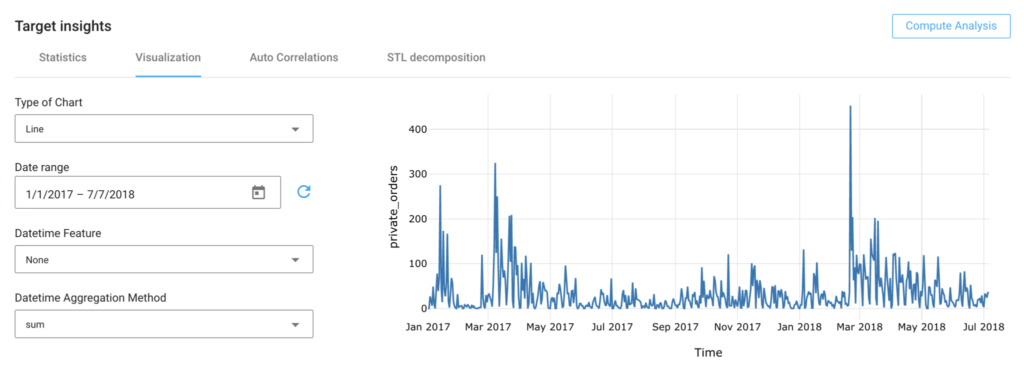
In the tab next to it, we can see an analysis of our database/
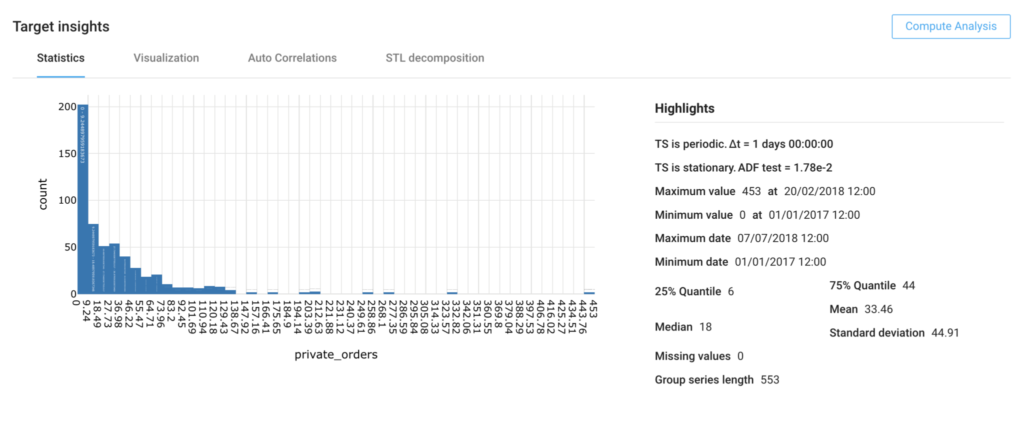
The statistics generated give us very useful information that could help us to become more familiar with our database.
The observations contain :
- The periodicity of the database is 1 day
- The data were collected between 01/01/2017 and 07/07/2018
- The minimum value was 0 on 01/01/2017
- The maximum value was 453 on 07/07/2018
- The Median was 18, the Mean was 33.46.
- No missing values.
- The size of the dataset is 553
3.a.2) Create Prototype :
When creating the univariate prototype we must first choose the ‘Data history to consider’, and the number of ‘Future values to forecast.
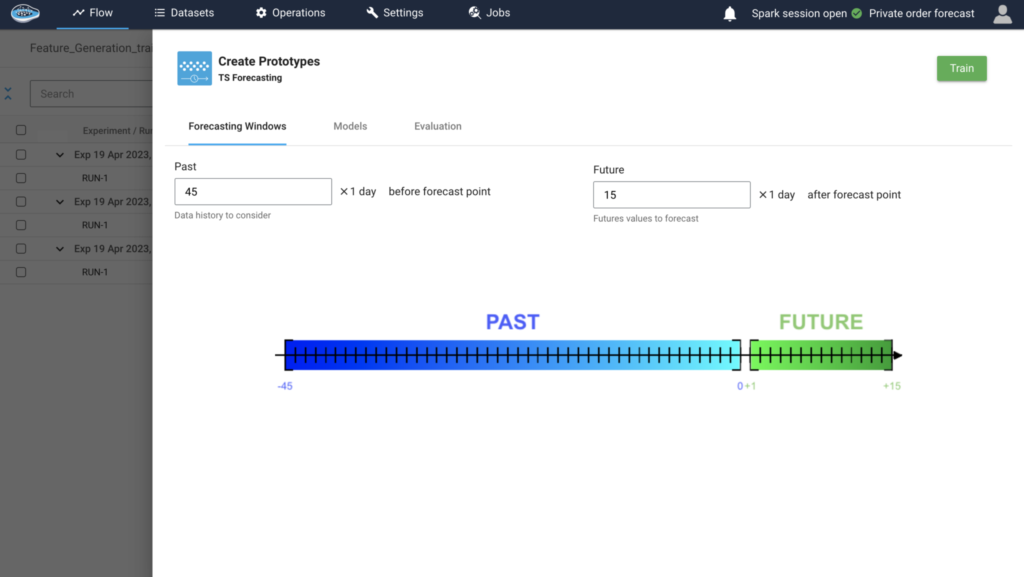
After defining the Forecasting windows, we have to choose the models we would like to train, in multivariate, there are 12 models which are the following
- ARIMA forecaster
- Block RNN
- LSTM
- GRU
- FFT
- LightGBM
- NBEATS
- Prophet
- Regular ML Models (Linear regression)
- Regular ML Models (Random Forest)
- SES
- TCN
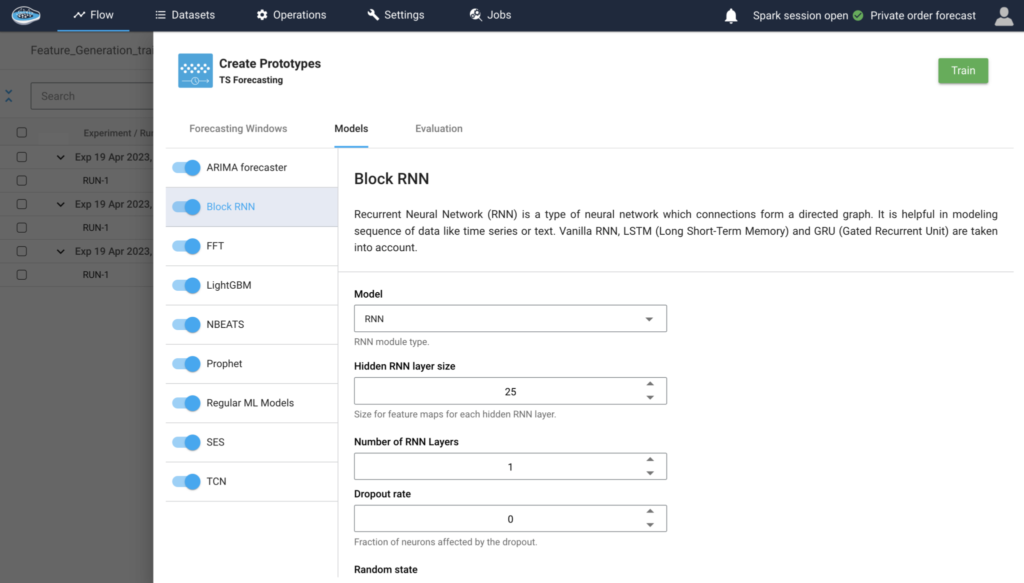
papAI solution guarantees an evaluation of each machine learning model. In order to set up the evaluation of our models.
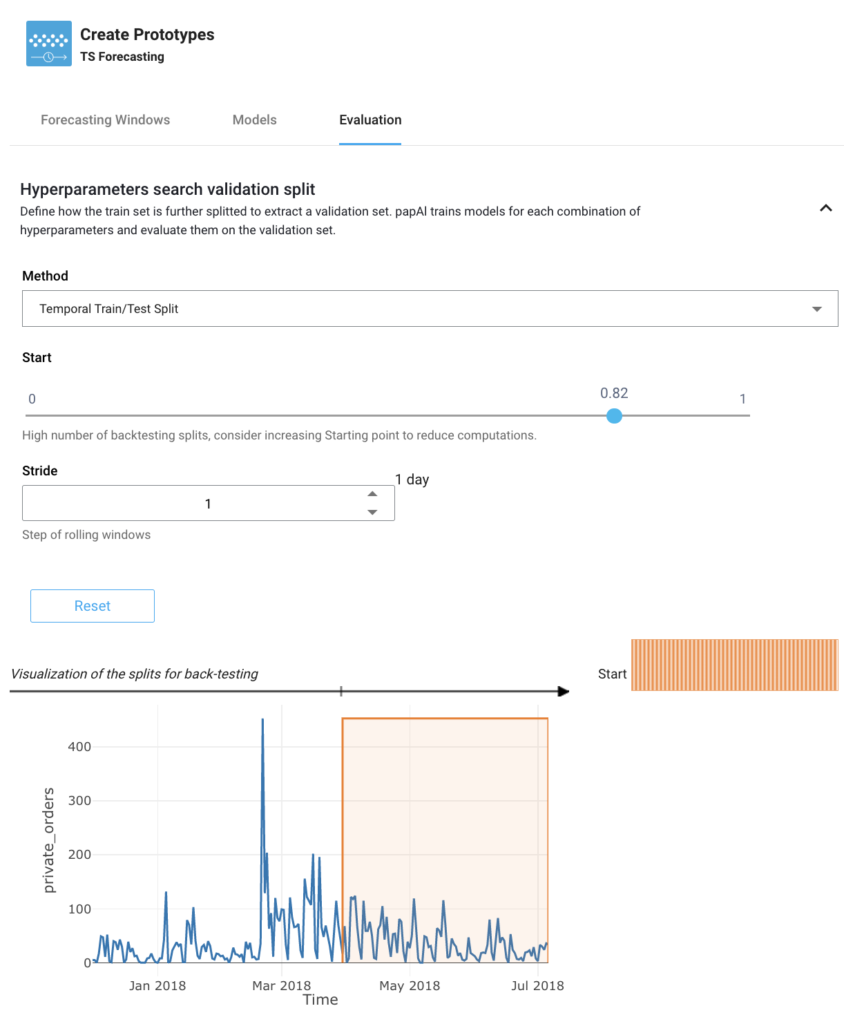
After starting the training, we get the evaluation of each model.
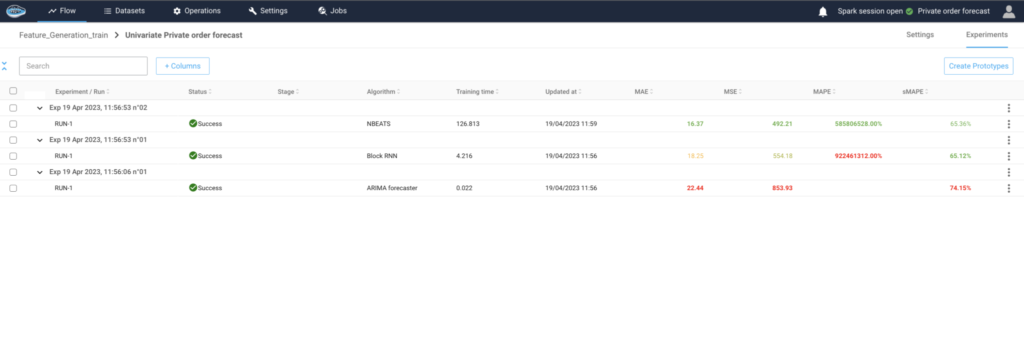
The best-evaluated model is the NBEATS.
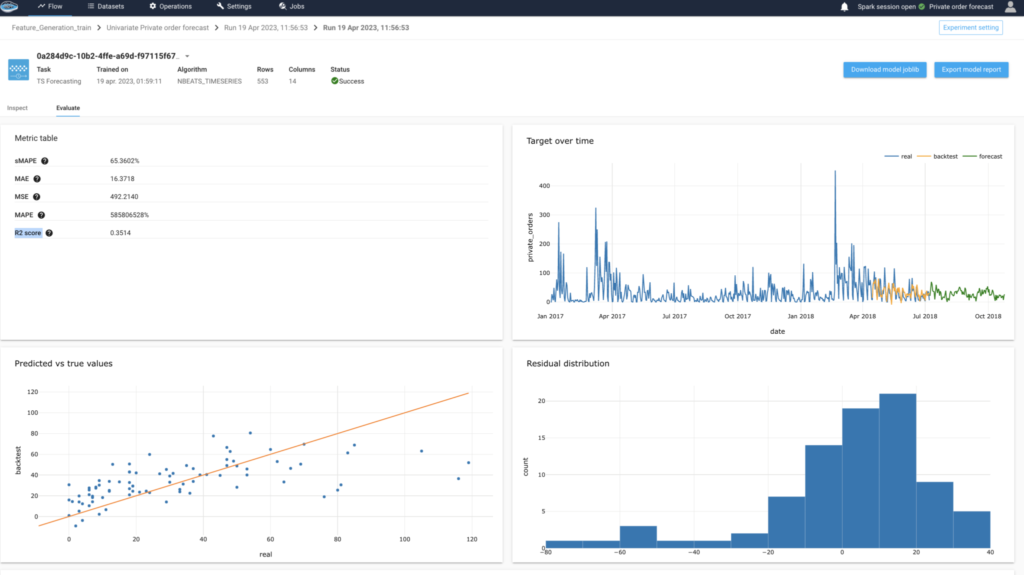
We can see in the evaluation which metrics have been taken into account:
Metric table with the (sMAPE, MAE, MSE, MAPE, R2 score)
Plot of the Target over time
Plot of predicted value vs true value on a backtest
Risidual distribution and risidual hilight
3.b) Multivariate:
When creating the Multivariate prototype we must first choose the features that can contribute to a better result.
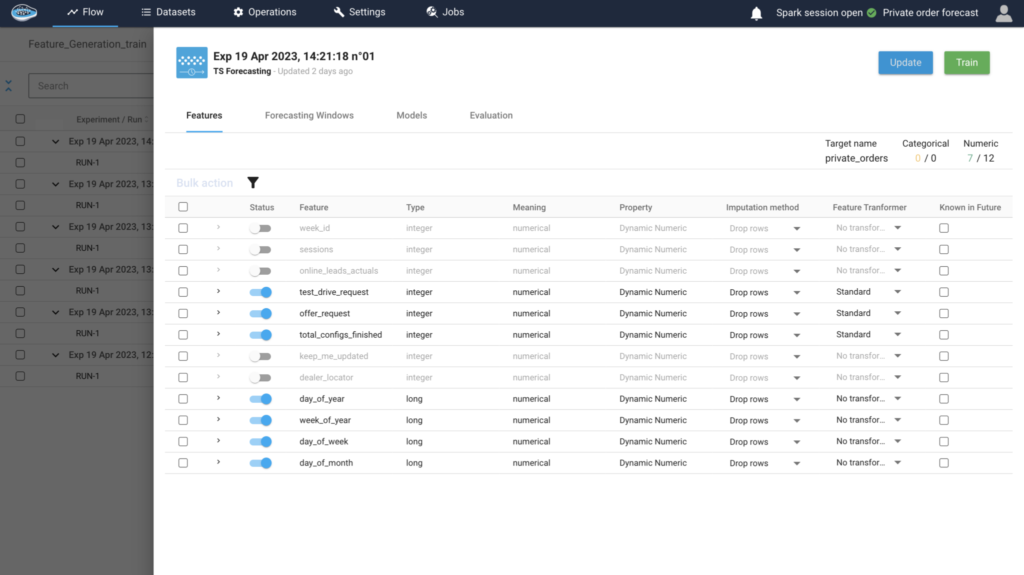
The second step would be to define the forecasting window with the number of points to be considered in the past and in the future.
The third step is to choose the models on which we would like to train the forecast.
In multivariate, papAI Solution has 16 models, which are the following
Block RNN(RNN)
Block RNN (LSTM)
Block RNN (GRU)
LightGBM
NBEATS
Regular ML Models ( Linear Regression)
Regular ML Models ( Random Forest)
TCN
DeepAR (LSTM)
DeepAR(GRU)
Temporal Fusion Transformer
MQ-CNN
DeepState (LSTM)
DeepState (GRU)
DeepFactor (LSTM)
DeepFactor(GRU)
4- AI Prediction
After evaluating and comparing the models we ran, the NBEATS model gave the best results, we will predict the number of sales per day for the next 4 months with the NBEATS model (univariate).
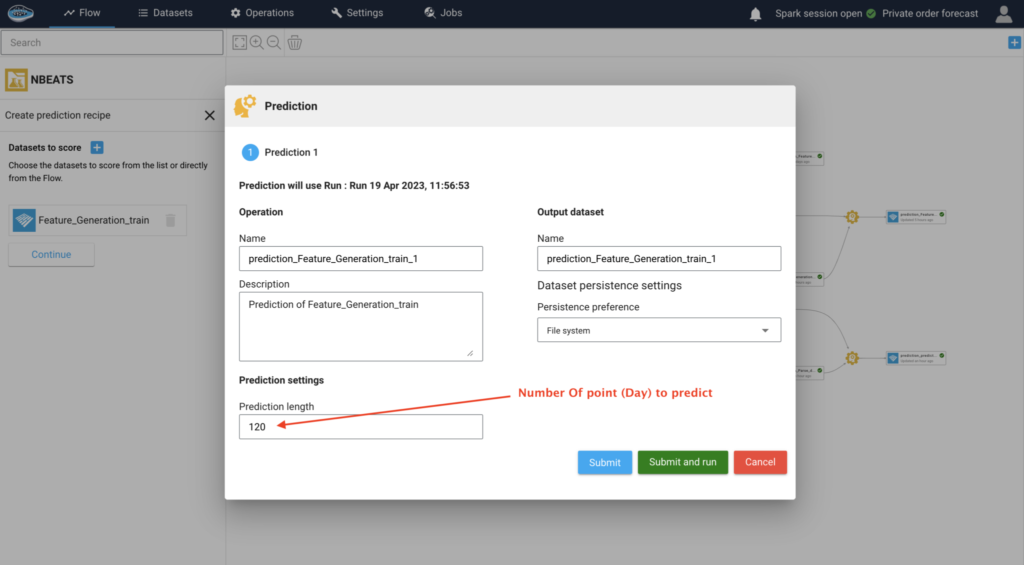
Viewing the results:
The result of the prediction is a data frame, with the values of the private order over the next 4 months following the last date of our dataset.
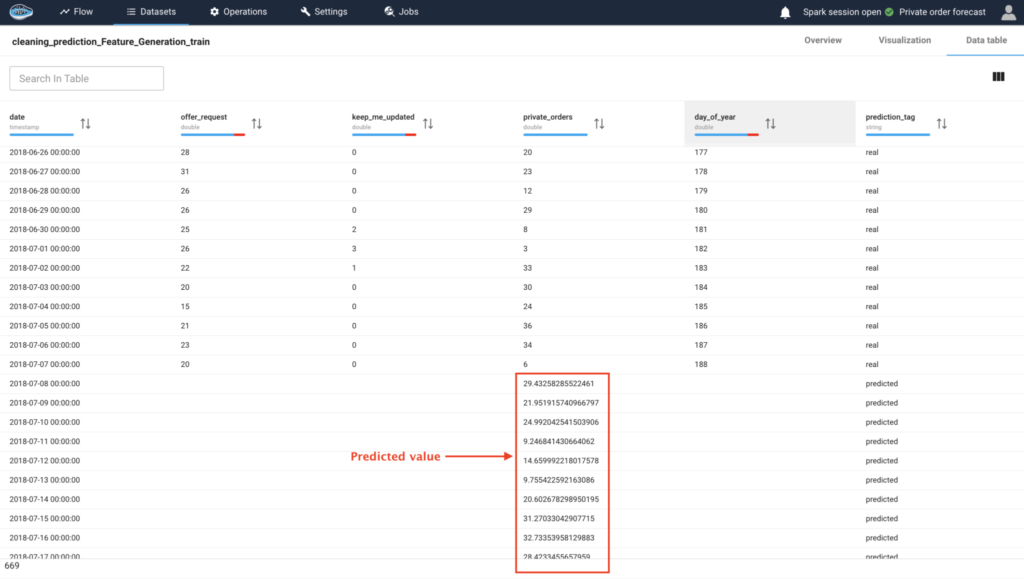
Create Your Own AI-based tool with papAI solution to Launch Your Predictive Analytics Models
In today’s dynamic business landscape, harnessing the capabilities of AI-based technologies for forecasting has become a necessity for organizations of all sizes. With papAI solution, businesses have the opportunity to craft their own AI-based tools, tailored to their specific requirements.
Beyond the forecast, papAI solution plays a pivotal role in providing transparency and insights throughout the entire AI project lifecycle. Through a rigorous process of data mining, cleaning, and visualization, it expedites the deployment of AI projects.
Book your demo now. Our team of experts can help you create a custom AI-based tool that meets the unique needs of your organization.
Interested in discovering papAI
Our team of AI experts will be happy to answer any questions you may have
How RAG Systems Improve Public Sector Management
How RAG Systems Improve Public Sector Management The most important...
Read MoreScaling RAG Systems in Financial Organizations
Scaling RAG Systems in Financial Organizations Artificial intelligence has emerged...
Read MoreHow AgenticAI is Transforming Sales and Marketing Strategies
How AgenticAI is Transforming Sales and Marketing Strategies Agentic AI...
Read More
